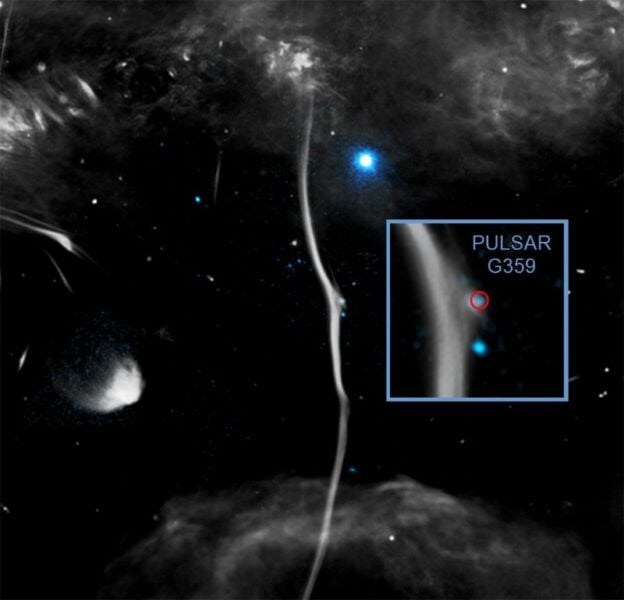A speeding neutron star has likely fractured a massive cosmic filament near the center of our galaxy, according to new research from NASA’s Chandra X-ray Observatory. This cosmic collision provides unprecedented insight into the mysterious magnetic structures threading through the Milky Way.
The filament, nicknamed “the Snake” due to its serpentine appearance, stretches an astonishing 230 light-years long near the galactic center. Astronomers have now identified what appears to be a high-speed pulsar – the dense remnant of an exploded star – that has smashed into the Snake at speeds between one and two million miles per hour.
“Astronomers have discovered a likely explanation for a fracture in a huge cosmic ‘bone’ in the Milky Way galaxy, using NASA’s Chandra X-ray Observatory and radio telescopes,” explains the research team in their announcement.
The Snake is one of many filamentary structures near our galaxy’s center visible in radio waves, but its unusual appearance with two distinct “kinks” has puzzled scientists for decades. These elongated formations are threaded by magnetic fields, which cause energized particles to emit radio waves as they spiral along these fields.
The combined X-ray and radio data revealed a source at the fracture site that shows characteristics of a pulsar – a rapidly spinning neutron star. These incredibly dense objects often receive powerful kicks during the supernova explosions that create them, sending them racing through space at extraordinary speeds.
When the pulsar collided with the Snake, it likely distorted the magnetic field structure of the filament, causing the radio signal to become warped and creating the distinctive break visible in observations. This collision also generated X-rays detected by Chandra.
This discovery offers astronomers a rare opportunity to study the interaction between high-energy objects and the magnetic structures that pervade our galaxy, potentially shedding light on similar phenomena observed in other galaxies.
If our reporting has informed or inspired you, please consider making a donation. Every contribution, no matter the size, empowers us to continue delivering accurate, engaging, and trustworthy science and medical news. Independent journalism requires time, effort, and resources—your support ensures we can keep uncovering the stories that matter most to you.
Join us in making knowledge accessible and impactful. Thank you for standing with us!

